| |
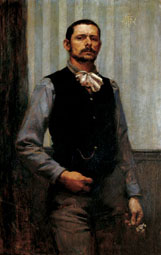
|
Teachers and Education
George Desvallières was the great-grandson and grandson of two members of the French Academy: respectively Gabriel Legouvé (1764-1812), and Ernest Legouvé (1807-1903). He was born on the 14th of March 1861 in the family home in Paris at 14, rue Saint Marc, where the salon was noted for the richness of its cultural activities. His father, Emile Desvallières, who occasionally made copies of fine pictures, was director of the Messageries Maritimes in Paris. Much concerned about the future of this second son, who was a dreamer and not much interested in studying, he confided the boy’s education to his father-in-law, Ernest Legouvé. George’s mother, Marie Legouvé, was an affectionate, energetic and pious lady. When Ernest Legouvé took George’s education in hand, he was the first to understand the artistic vocation of his grandson, who was then just fifteen years old. He gave him a taste for Greek tragedy, and the rue Saint Marc Salon, which was frequented one after the other by many of the greatest names in French literature, music, and the fine arts, completed his education. In 1877 Ernest Legouvé introduced George to the painter Jules-Elie Delaunay (1828-1891) who had won the Prix de Rome in 1856, had been trained by Ingres, Flandrin and Delacroix, and had distinguished himself by his opposition to the academic school of painting. Having become his master, Delaunay taught George a sound drawing technique, some well-grounded principles of composition and a taste for original colours.
|
|
In 1878, George entered the Académie Julian (art school) in the Passage des Panoramas in Paris. His teachers were Tony Robert-Fleury and Jules Valadon. There he met the painters René Ménard (1862-1930) and René-Xavier Prinet (1861-1946), who were the friends and accomplices of his first artistic activities. In the same year, Elie Delaunay introduced him to Gustave Moreau (1826-1898), whom he had met during his stay at the Villa Médicis (French cultural institute) in Rome from 1857 to 1860. This meeting left a lasting impression on George who, under Gustave Moreau’s influence, radically changed his thinking about being an artist: instead of the fashionable social painter he might have been, he became a true independent artist. Accepted at the Ecole des Beaux Arts in Paris 1880, the same year that Elie Delaunay was appointed a teacher, George remained there for only one year: he undertook his voluntary military service at Orleans (1880-1881) alongside Lucien Simon (1861-1950), who was to join him subsequently at the Académie Julian, and become one of his most faithful admirers and friends. In his studio, set up by his grandfather in the rue Saint Marc, George started painting, taking his inspiration from his researches at the Louvre. He worked alone, away from any schools of art, and kept his teachers informed of his discoveries. On their advice he travelled several times to Italy to study the Primitives, the Renaissance masters, and the light of the Italian landscapes.
|
Hercules picking the golden apple, 1892
|
|
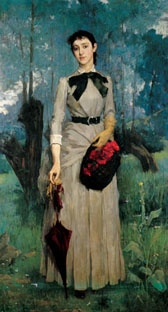
Portrait of Melle D., 1883
|
|
First Exhibitions and Salons
George Desvallières exhibited for the first time at the Salon des Artistes Français in 1883: his Portrait de Melle D. (1883) attracted the attention of Puvis de Chavannes. The following year he was appointed secretary of the Salon des Artistes, and he exhibited his paintings there until 1901. The influence of Gustave Moreau is already clearly apparent in his early portraits: he contrived to bring out the inner flame of his model’s personality placed in an increasingly rich and meaningful décor: Autoportrait (Self-Portrait: 1891), Un Coin de Salon (A Corner of the Sitting Room: 1891) also titled Family Music. Thereafter he painted more and more pictures inspired by classical mythology: Hercule cueillant la pomme d’or (Hercules picking the golden apple: 1892), Narcisse (1893), La Nymphe (1896), L’Orgie (1897), Ulysse et Nausicaa (1898). In 1901 he rendered explicit homage to the painter of Prétendants (The Suitors) with an enormous pastel entitled Aeternum Transvertere (2.15 by 4.21 metres). Henceforth he was greatly concerned to bring out his inner feelings and to penetrate the soul and reveal the invisible feelings of every creature that he depicted from Antiquity. His classical education was not negligible in enabling him to reach this objective. His decorative work, whether profane or religious, was all together marked by this concept of painting inspired by Gustave Moreau.
|
|
In 1890 George Desvallières married Marguerite Lefebvre (1870-1955), a piano pupil of César Franck. They had six children: Sabine born in 1891 (Gustave Moreau’s god-daughter), Richard (1893), Daniel (1898), Marie-Madeleine (1908), Monique (1911) and France (1915). Marguerite was endowed with a remarkable spirit of discernment and she was highly pragmatic. She constantly advised her husband on his approach to painting, and she ensured the material organisation of his life as an artist. His struggle to communicate his message to the world was carried out with the support of his wife’s determination, self-sacrifice and confidence.
|
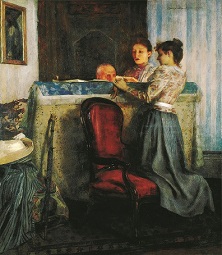
|
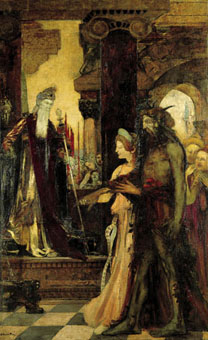 Nausicaa introduces Ulysses to her father, 1898 Nausicaa introduces Ulysses to her father, 1898 |
On the death of Elie Delaunay in September 1891, Gustave Moreau took his place as teacher at the Ecole des Beaux-Arts. This gave George the opportunity of meeting Moreau’s pupils, René Piot, Georges Rouault and Matisse, with whom he formed deep, lasting and friendly working relationships. Having been awarded several medals for his painting since 1890, he was finally officially recognised by being appointed a member hors concours (without competing) of the Salon de Artistes Français in 1895. In the same year, during his journey to Sicily, he discovered the light for his large decorative canvases Ulysse et Nausicaa, that were destined to adorn the circular walls of the family dining-room in Paris.
|
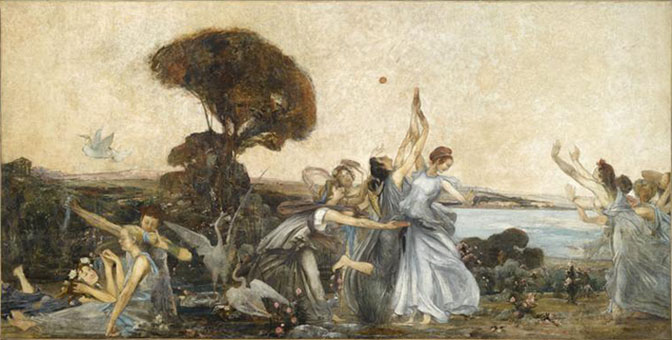
© Archives de l'Oise (Beauvais, MUDO - Musée de l'Oise)
Nausicaa's maids and their games, 1898
|
|
About The Salon d'Automne
Following the death of Gustave Moreau in 1898, and that of his grand-father Legouvé in 1903, George made his own way. As a first step, he abandoned the Salon des Artistes Français in 1901 for a more liberal Salon, the Salon National des Beaux-Arts. Georges Rouault introduced him to Léon Bloy (1846-1917), who greatly influenced him spiritually. His trip to London at the end of summer 1903 where he hoped to do society portraits following the success of that of Madame Blanchard, was to be decisive. Armed with his sketchbooks and drawing-papers, he decided to work from life in the music-halls, theatres and streets.
|
|
© Ville de Paris (Petit Palais, Musée
des Beaux-Arts de la ville de Paris)
Portrait of Mme P.B., 1903
|
|
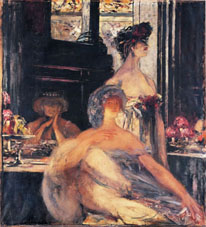
© Ohara Museum of Art, Kurashiki
|
On his return to Paris, Devallières devoted himself to the creation of the Salon d’Automne ( George Desvallières et le Salon d'Automne, sous la direction de Catherine Ambroselli, Editions Somogy, Paris 2003). The objective was to open a new salon, “whose role is to be excessive because the role of the other salons is to be quite the opposite”, for forgotten masters and for talented artists that were currently excluded from official exhibitions. This was the beginning of a long adventure that was to keep him busy for more than forty years. The first Salon d’Automne opened its doors in Paris at the Petit-Palais on the 31st of October 1903: in particular, eight works by Paul Gauguin, which had disappeared but now exhibited. As joint founder and vice-president, George Desvallières presented a portrait of his mother (1903) and Choses Vues (Things Seen), the first of his famous “Femmes de Londres” (Women of London).
|
|
At the second Salon d’Automne, Desvallières exhibited other works from his stay in London: he no longer painted his models in gold-panelled rooms, but rather in dark rooms with subdued lighting; faithful to his late master (Gustave Moreau), he presented his viewers with the interior struggles of the livers-by-night he met by chance, with his own genius and sensibility. In these sketches executed with broad brush-strokes and swathes of light and shade, one can perceive the technique and touch of Toulouse-Lautrec, who was than unknown to the public. The following year Desvallières presented a retrospective exhibition of his works.
Thus, in the Salons d’Automne, of which he became President in 1936, Desvallières contrived to attract public attention to unknown artists; he opened its doors to artists rejected by the Salon National des Beaux-Arts, and became the unbiassed protagonist of the Fauves. He took up their defence after the 1904 Salon, and also that of the Cubists in 1904, who gave rise to the famous scandal of the Salon d’Automne in 1912, without any fear of the fashionable critics.
|
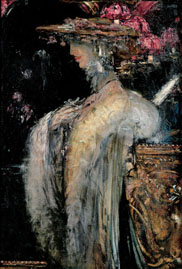
|
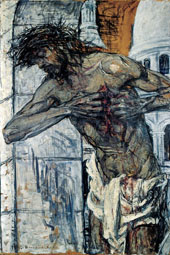
|
Religious Conversion
From 1905 on, Desvallières’ return to the Christian faith was progressively confirmed by his own personal reflections, and brought about a radical change in his life. The anguish of a struggle between grace and sin, already recognizable in his Femmes de Londres, appeared clearly in his illustrations to Alfred de Musset’s Rolla (1905). Henceforth he perceived, in the distress of his models, Christ Incarnate sharing the sufferings of humanity. Was it the influence of Léon Bloy or that of Georges Huysmans, or his vision of the Sacré-Cœur (Sacred Heart: 1905) above Pigalle, or perhaps the simple piety of the faithful in the silence of a church, that brought about his conversion to the Roman Catholic Church ? A thousand intangible factors somehow then transformed his existence and his life. Like the Primitives, he painted more and more religious subjects in the framework of his family, and of his daily life, portraying the Annunciation (Annonciations: 1910 and 1912) and the Nativity (Nativités: 1913) in his domestic surroundings and childhood furnishings. This course led him to become a Dominican Tertiary on the 11th of April 1926, while his daughter Sabine was to become, a little later on, a Poor Clare nun at Mazamet, and to take the name of Sœur Marie de la Grâce.
|
Decorative Works
In parallel, since 1907, Desvallière’s mythological compositions became more simple. As for Mantegna and Michaelangelo, the human body remained his supreme architectural paragon. In his great decorative paintings, he eliminated unnecessary detail in order to return to basic vegetable and animal nature. His friend Jacques Rouché, Director of the Paris Opera, gave him the opportunity to unleash this new vivacious tendency, by entrusting him with the decoration of the music-room in his private house. He carried this out using warm colours like the Fauvists (1907-1908). In the same manner, and for the same patron, he painted Eros, La Vigne (The Vine), La Grèce (Greece: 1910) and Hercule au jardin des Hespérides (Hercules in the Garden of the Hesperides: 1914). Impressed by the essential role played by Desvallières at the Salon d’Automne, Jacques Rouché entrusted him with the art critic’s column in La Grande Revue from 1907 on. On being appointed Director of the Théâtre des Arts for the 1910-1911 season, Rouché asked Desvallières to help him with the renewal of the decors and costumes in the spirit of Diaghilev and the Ballets Russes, who had been commissioning artists in this area since 1909. Desvallières worked more especially on three productions: Anathema, by Leoonid Andreieff (1911), Istar by Vincent d’Indy (1912) and Orphée by Glück (1913).
|
|
© Musée d'Orsay, Paris
The Christ at the Whipping-Post, 1910
|
|
Artists Able to Communicate with People Indifferent to Religion
In 1910 George Desvallières became a member of the Société de Saint Jean (for the Encouragement of Christian Art). His sponsors were Paul-Hippolyte Flandrin and Maurice Denis. Already in 1911 he had considered creating a school for religious art (Ecole d’Art Religieux), an idea that he had first made public in 1912 in an article entitled: “Projet pour une école d’art, placée sous la protection de Notre-Dame de Paris” (Project for a school of art under the protection of the Virgin Mary). “In this school we want to form artists that can address religiously indifferent people who walk past the ornamentation of a church-porch, just as our ancestors knew how to communicate with their contemporaries on sacred history, as recounted all along the walls of our cathedrals”. He recommended an audacious approach to art inspired by the Gospels. It was only after the First World War in 1919 that George Desvallières was able to carry out this project by founding, together with Maurice Denis, the Ateliers d’Art Sacré (Sacred Art Studios), whose inspiration and impulsion were those of 1912.
|
Trials of the Great War
War broke out in the summer of 1914. Having enlisted voluntarily at the age of fifty-three, Desvallières arrived in Nice on 4th of August to await his posting. Having been appointed provisional battalion commander of the Chasseurs Alpins because of his age, he was confirmed in this appointment at the demand of his men when he was transferred to the front in Alsace on the 15th of February 1915. From time to time he took the risk of advancing beyond his own lines. It was on the occasion of one of these sallies, when he had passed close to death, that he vowed to paint only religious subjects in the future: a vow that he kept scrupulously until the end of his life. During these four years of warfare, he proved himself to be an outstanding leader of men, capable of encouraging and supporting his troops in the hell of the trenches.
|
|
|
The Sacrifice of War (detail), 1922
|
|
On resuming his artistic activities in 1919 Desvallières began by paying homage, in Le Drapeau du Sacré-Cœur (Banner of the Sacred Heart) to the victims of the slaughter in which his son Daniel, aged only seventeen, had been taken from him. His threnodial testimony found its passionate expression in the decoration of the Chapelle de Saint Privat on the estate of his friend Jacques Rouché (1919-1924): on all the four walls of the chapel he hung enormous canvases, and placed in the middle an image of the Man of Sorrows, the Christ of the Drapeau du Sacré-Cœur, offering His heart in a maelstrom of shrapnel and gunfire, and leading forth his soldiers entrenched underground in an Ascension towards the deliverance of the New Paradise. His acute distress was sublimated by his faith. Following his war experience in Alsace, Desvallières centred his work on the Mystery of the Incarnation which entails the Crucifixion of the One who takes on himself all the sufferings of humanity. He evokes this scene with all the realism of someone who has personally lived through the horror of the trenches, and with all the distress of a father whose son has been cut down by a shrapnel-explosion only a few miles away from him. From then on, from the Crib to the Cross, the “suffering servant” of Isaiah would be at the centre of his pictorial work.
|
Les Ateliers d'art sacré
While working on this masterpiece, Desvallières, together with Maurice Denis, founded the Ateliers d’Art Sacré, thus finally materialising his project of 1911-1912. The two masters decided to form their pupils in the same way as the builders of the cathedrals: a brilliant group of young talented artists threw themselves into this adventure. Up to 1940 they were to carry out together major plans for church decoration, and other religious projects in which their pupils participated actively: Pavillion de Marsan (1921), the religious section created by Desvallières at the Salon d’Automne (1922), the Church of the French Village at the Exposition Internationale des Arts Décoratifs (1925) for which he painted La Sainte Face (The Holy Face), the Eglise du Saint Esprit (Church of the Holy Spirit in Paris: 1935) and the Pontifical Pavilion at the Exposition Internationale (1937).
|
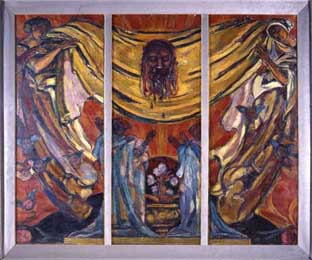
|
Foto Servizio Fotographico Musei Vaticani © Musei Vaticani
The Holy Face, 1925
|
|
|
|
Desvallières, while continuing to produce personal works which he exhibited in different salons and galleries, undertook numerous major church decoration projects. He was never to abandon this kind of work for which he was always enthusiastic. In 1926, he painted L’Ascension and O Salutaris Hostia for the Church of Saint John the Baptist in Pawtucket (New England). In 1927, he provided the sketches for the stained glass windows of the ossuary at Douaumont (sanctuary for the dead at Verdun). In 1928, he sent another work to Pawtucket, the Annonciation. In Alsace, he was asked to decorate the new church at Wittenheim, a small town inhabited mostly by Poles who were working in the potash mines: assisted by several of his pupils from the Atelier d’Art Sacré he produced there, between 1929 and 1931, Le Triomphe de sainte Barbe in the choir, Les Dix Commandements (The Ten Commandments), the decoration of the baptistry, the sketches for the stained glass windows and the more than life-sized Chemin de Croix (Way of the Cross), a central feature of the sanctuary, poignantly recalling the sufferings undergone at Hartmannswillerkopf in the Vosges during the First World War.
|
In 1931, Desvallières undertook the decoration of the oratory of the Cité du Souvenir in the 14th Arrondissement of Paris. In 1933, he painted a large panel Saint Joseph et les Ecoliers (Saint Joseph and the Schoolboys) for the Chapel of Saint Aspais College in Fontainebleau. In 1935, he made a further contribution to the Eglise du Saint Esprit in the 12th Arrondissement of Paris with a new Chemin de Croix (Way of the Cross) which covers part of the walls of the side-aisles of the nave.
|
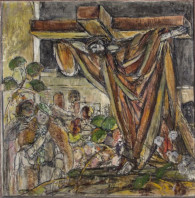
|
Way of the Cross, Eglise du Saint Esprit, 1934-1935
|
|
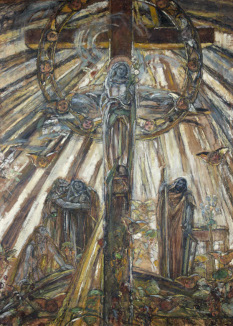
|
In 1936, his pre-war dream of painting the Glorious Virgins at last came true. Sainte Vierge Reine des anges (Virgin Mary Queen of the Angels), a masterpiece that was originally in the Poor Clares’ Convent in Mazamet (4.50 metres high), now adorns the Benedictine Monastery of Abu Gosh in Israël. Le Couronnement de la Vierge par la Trinité (The Coronation of the Blessed Virgin by the Trinity), offered in thanksgiving by the artist to the Chapel of Ruelsheim in Alsace, is still close to Wittenheim. The Musée d’Orsay now has taken charge of Sainte Marie Reine des Anges (Holy Mary, Queen of the Angels), purchased by the French State. Finally a few private collectors and amateurs benefit from Desvallières theological compositions on the Virgin Mary. Subsequently he was asked to decorate the chapel of the Seminary at Meaux, commissioned by the diocesan bishop, a major project which he completed in 1937. In the same year, at the Exposition Internationale (International Exhibition of Decorative Art), the Pontifical Pavilion presented his seven-metres-high La Réconciliation. In the middle of the Second World War, he painted two large canvases intended for the Cathedral of Arras, Nativité and Résurrection, delivered in 1942; he was eighty-one years old at the time. Then, in spite of his advanced age, he decorated the Chapel of the Hermitage at Nancy with four large canvases.
|
|
Whilst working energetically on all these important projects, Desvallières continued to illustrate books, beginning with Rolla (1905), then, in 1914, La Princesse Lointaine (The Far-Away Princess) in the appropriate fauve colours for Edmond Rostand’s imagined adventure. He produced hundreds of small-scale works for the illustration of religious books; La Vie de Marie (1927), Le Chœur de jeunes hommes (The Young Mens’ Choir: 1934), Monsieur Vincent (Saint Vincent de Paul: 1936), Thérèse Martin (Saint Theresa of the Child Jesus: 1948), Les Cahiers clandestins du témoignage chrétien (The Secret Files of Christian Witness: 1946) and Le Petit Office de la Sainte Vierge (The Holy Virgin’s Book of Hours: 1947).
|
|
La vie de Marie
« The Nativity », 1927
|
|
Being All Things To All Men
Alongside his painting, Desvallières’ taste for the spoken and written word led him to take part in discussions with numerous articles, lectures and speeches in religious and charitable societies and associations which he either presided or enlivened. Besides his involvement in the Salon d’Automne of which he had been vice-president since 1903, he continued be extremely active in the world of the arts. In 1923, he took part in the foundation of the Salon des Tuileries. In the same year he was a member of the jury for the International Exhibition of the Carnegie Institute in Pittsburgh, as member of the French committee. On his journey to the United States he had a triumphal reception as renovator of religious painting in France, but above all as painter and soldier of the First World War. He exhibited his picture from Saint Privat Dieu le Père (God the Father) which greatly impressed the public and the officials by its dimensions and its treatment of the subject. In 1925, he became Artistic Director of the Ecole Chardin.
|
|
|
In July 1929, Desvallières succeeded Georges Rouault who had just resigned from the position of Curator of the Musée Gustave-Moreau. In January 1930, he was elected member of the Académie des Beaux-Arts of Belgium, and, in the following month of May, member of the Institut de France in replacement of his friend René Ménard. The Fra Angelico Association d’Entraide aux Artistes appointed him president of their Management Committee in 1933. In March 1934, he signed Jacques Maritains’ manifesto Pour Le Bien Commun, in favour of Christian socialism. The following year, he took part in the creation of L'Art Sacré review and was on its editorial committee. After Frantz Jourdain’s death in the summer of 1935, he was elected president of the Salon d’Automne in 1936. In December 1938, he took position in favour of the new stained glass windows for the Cathedral of Notre-Dame de Paris. He became President of the Institut de France in January 1940, President of the Société de Saint Jean in 1943, and Honorary President of the Salon d’Automne in 1947.
|
|
First Communion of Saint Thérèse, 1938
|
|
|
Christ presents his mother, 1941
|
|
These numerous activities at the highest level of a man always in search for innovations in order to enhance the world around him, bear witness to a permanent concern for self-sacrifice, for being “all things to all men”, until the end of his days. Immersed in a sphere in which culture was passed on from generation to generation, George Desvallières developed his gifts as a painter, as an orator and as a critic in privileged conditions. Formed in the Italian School of painting, he left behind landscapes and portraits of great beauty. His mythological compositions reveal the concerns and misgivings of a rather tormented young painter. His “Femmes de Londres”, sketched from life and exhibited at the first two Salons d’Automne somehow express his own interior conflict.
|
George Desvallières transmitted the mystery he caught sight of above a street in Pigalle, or at the back of a church in Paris, by means of his ceaseless labour during an entire half-century for ever marked by the two World Wars: in his masterly church decorations, his small water-colours, his lectures on sacred art or his speeches at the Institut. Dazzled by his encounter with Christ, he revealed in the substance of his painting, of his drawings or of his writings, behind the theatre curtains which he so loved depicting, the spiritual world he had apprehended. Witness of the invisible, he wanted to share the beauty he had discovered. Faithful to his beloved Gustave Moreau, he disclosed a marvellous art, “that which, beneath a material veil, mirror of physical beauty, also reflects the great uprushes of the soul, of the spirit, of the heart and of the imagination, and satisfies the divine needs of humanity of all ages: it is the language of God.” (L’Assembleur de Rêves (The Collector of Dreams), writings of Gustave Moreau, annotated by Pierre-Louis Mathieu, Fata Morgana, 1984, p. 184). |
|
| |
Translation by David Baird-Smith, 2010.
© Catherine Ambroselli de Bayser, 2000-2010 | Contacts | Home
|
